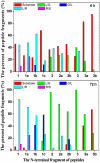Length-dependent proteolytic cleavage of short oligopeptides catalyzed by matrix metalloprotease-9
- PMID: 23520037
- PMCID: PMC3920740
- DOI: 10.1002/bip.22240
Length-dependent proteolytic cleavage of short oligopeptides catalyzed by matrix metalloprotease-9
Abstract
Matrix metalloproteinases (MMPs), as the enzymes to degrade extracellular matrix proteins, play a major role on cell behaviors. Among them, MMP-9 usually catalyzes the degradation of proteins with the dominant cleavage at G/L site. Recent high-throughput screening suggests that S/L is a new major site for the cleavage when the substrates of MMP-9 are oligopeptides. Here we examine the cleavage sites of the N-terminal substituted short oligopeptides as the substrates of MMP-9. As the first example of such study of N-substituted small peptides, our results suggest that the substitute group at the N-terminal and the length of peptides significantly affect the position of the cleavage site on the oligopeptides, which provides a useful insight for the design of small peptide derivatives as the substrates of MMP-9.
Keywords: MMP-9; N-terminal substitution; oligopeptide; proteolytic sites.
Copyright © 2013 Wiley Periodicals, Inc.
Figures



Similar articles
-
Colon tumour secretopeptidome: insights into endogenous proteolytic cleavage events in the colon tumour microenvironment.Biochim Biophys Acta. 2013 Nov;1834(11):2396-407. doi: 10.1016/j.bbapap.2013.05.006. Epub 2013 May 15. Biochim Biophys Acta. 2013. PMID: 23684732
-
Family-wide characterization of matrix metalloproteinases from Arabidopsis thaliana reveals their distinct proteolytic activity and cleavage site specificity.Biochem J. 2014 Jan 15;457(2):335-46. doi: 10.1042/BJ20130196. Biochem J. 2014. PMID: 24156403
-
Deep Profiling of the Cleavage Specificity and Human Substrates of Snake Venom Metalloprotease HF3 by Proteomic Identification of Cleavage Site Specificity (PICS) Using Proteome Derived Peptide Libraries and Terminal Amine Isotopic Labeling of Substrates (TAILS) N-Terminomics.J Proteome Res. 2019 Sep 6;18(9):3419-3428. doi: 10.1021/acs.jproteome.9b00325. Epub 2019 Aug 8. J Proteome Res. 2019. PMID: 31337208
-
Next generation matrix metalloproteinase inhibitors - Novel strategies bring new prospects.Biochim Biophys Acta Mol Cell Res. 2017 Nov;1864(11 Pt A):1927-1939. doi: 10.1016/j.bbamcr.2017.06.009. Epub 2017 Jun 19. Biochim Biophys Acta Mol Cell Res. 2017. PMID: 28636874 Review.
-
Redefining metalloproteases specificity through network proteolysis.Trends Mol Med. 2024 Feb;30(2):147-163. doi: 10.1016/j.molmed.2023.11.001. Epub 2023 Nov 29. Trends Mol Med. 2024. PMID: 38036391 Free PMC article. Review.
Cited by
-
Self-Complementary Zwitterionic Peptides Direct Nanoparticle Assembly and Enable Enzymatic Selection of Endocytic Pathways.Adv Mater. 2022 Jan;34(1):e2104962. doi: 10.1002/adma.202104962. Epub 2021 Oct 20. Adv Mater. 2022. PMID: 34668253 Free PMC article.
-
Integrating Enzymatic Self-Assembly and Mitochondria Targeting for Selectively Killing Cancer Cells without Acquired Drug Resistance.J Am Chem Soc. 2016 Dec 14;138(49):16046-16055. doi: 10.1021/jacs.6b09783. Epub 2016 Dec 1. J Am Chem Soc. 2016. PMID: 27960313 Free PMC article.
-
Nanoscale Assemblies of Small Molecules Control the Fate of Cells.Nano Today. 2015 Oct;10(5):615-630. doi: 10.1016/j.nantod.2015.09.001. Epub 2015 Oct 20. Nano Today. 2015. PMID: 26900396 Free PMC article.
-
The Impact of Tyrosine Iodination on the Aggregation and Cleavage Kinetics of MMP-9-Responsive Peptide Sequences.ACS Biomater Sci Eng. 2022 Feb 14;8(2):579-587. doi: 10.1021/acsbiomaterials.1c01488. Epub 2022 Jan 20. ACS Biomater Sci Eng. 2022. PMID: 35050574 Free PMC article.
-
Customizing Morphology, Size, and Response Kinetics of Matrix Metalloproteinase-Responsive Nanostructures by Systematic Peptide Design.ACS Nano. 2019 Feb 26;13(2):1555-1562. doi: 10.1021/acsnano.8b07401. Epub 2019 Jan 30. ACS Nano. 2019. PMID: 30689363 Free PMC article.
References
-
- Whitesides GM, Mathias JP, Seto CT. Science. 1991;254:1312–1319. - PubMed
-
- Schneider JP, Pochan DJ, Ozbas B, Rajagopal K, Pakstis L, Kretsinger J. J Am Chem Soc. 2002;124:15030–15037. - PubMed
-
- Silva GA, Czeisler C, Niece KL, Beniash E, Harrington DA, Kessler JA, Stupp SI. Science. 2004;303:1352–1355. - PubMed
-
- Zhou M, Smith AM, Das AK, Hodson NW, Collins RF, Ulijn RV, Gough JE. Biomaterials. 2009;30:2523–2530. - PubMed
Publication types
MeSH terms
Substances
Grants and funding
LinkOut - more resources
Full Text Sources
Other Literature Sources
Research Materials
Miscellaneous

